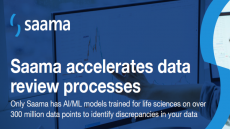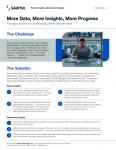Protocol First: Source Upload facilitates trial continuity during COVID-19

Onsite monitoring of trials can require a great deal of work, travel and clerical tasks. Especially in the face of the global pandemic, sponsors and CROs are looking for ways to minimize the need for staff to travel to sites for monitoring and other functions.
Protocol First has introduced Source Upload, a remote monitoring solution designed to empower compliant, efficient uploading of trial data. Outsourcing-Pharma (OSP) recently spoke with Hugh Levaux (HL), founder and CEO of Protocol First, about the evolution of remote monitoring, and how this solution can help sites streamline their operations.
OSP: Please tell us about Source Upload--what it is, what it does, and what users it’s best suited for.
HL: Source Upload is a tool that allows the upload of patient-identifiable information into a HIPAA-compliant repository. It allows a sponsor or the CRO monitors to review in an organized manner, with all the regulatory and data privacy requirements they need to use. It is suitable for any therapeutic areas, but especially for trials that require review of a safety endpoint.
OSP: Now, please tell us a little bit about remote and decentralized technology in trials—specifically, how the technology has been evolving, and how attitudes toward adoption and use have changed?
HL: The challenge of remote and decentralized clinical trials lies in the mixing and overlap of patient information with research data. By design, the pharma sponsor is not allowed to know who the patient is that’s being treated--when you want to do something remotely, how do you ensure John Smith is Subject 101 in the trial, and that the documentation that ends up in your database is correct?
This technology allows you to do just that, and Protocol First has been spearheading it for five years. With one user interface, it enables you to block access to one type of data; it uses one centralized platform, even though access is different and controlled.
Site users know who John Smith is, and that all this particular research data is from John Smith the trial participant. At the pharma company, everyone knows Subject 101—they have no idea of the name.
Then, there is one person in the middle who does the monitoring; they are required to know that John Smith is indeed Subject 101, and that the lab results and adverse event form filled out on Subject 101 indeed came from that patient. We created technology that makes it so the user in the middle is able to view the data available to doctors and nurses, but it not accessible by anybody else.
The attitude in the industry is slow to change—when people say this industry is very slow and conservative, it’s almost a badge of honor. It is very hard to move forward and jump onto new approaches.
The adoption of our technology has been along those lines. People could not solve their operational problem any other way, so they turn to our technology. It’s out of necessity—fast-moving trials, and the need for availability of data in a centralized matter is really a driving force for customers.
With the pandemic, people are realizing this tech is not just nice to have; it’s a must-have. Trials are blocked or stuck because they can’t verify data on an ongoing basis. As a trial nurse is adding data about John Smith, the sponsor can’t verify it.
OSP: Could you please tell us a little background on remote monitoring—how its use has changed, how attitudes have evolved, and why it’s useful?
HL: Monitoring has been used historically as a way to verify that tie, that John Smith is indeed Subject 101. In the past, the solution was to fly or drive the monitor to the site to verify the data. The promise of remote monitoring is to say, If we could put the data in a central location digitally, we could offer that capability remotely.
Historically, when data is available it is redacted—literally, a nurse or another staff member takes a black pen and marks off any identifying information about John Smith. The site and nursing staff upload the redacted data for review.
The two main problems are that, one, redaction is a lot of work and, two, it is virtually impossible to remove all patient identifiers. Sometimes, in the header, footer or interspersed in the document, things get missed; if you're not perfect, and you leave in the ZIP code or birth date, now you've violated HIPAA and privacy laws.
It’s been a very slow-moving process. One solution that exists today is a portal approach. There are additional levels of control, so you can have patient health info in there, which is good.
The problem with the portal approach, though, is it is a static filing system that you need to create some form of structure to work. You say, “Please upload the chemistry panel for John Smith for visit two of the trial"—you have to manage and number documents.
This approach can work, but it's a lot of work compared to saying, "I know my trial--John Smith had a chem lab result on visit two, just let me access it in Source Upload." You don't need to number it or "attach" the chem panel to that visit. P1 Source Upload "auto-tags" the source to the correct visit. If you encounter an FDA audit two years down the road, it's attached to this visit and easy to access. No need for extra reconciliation or searching for source"
OSP: Why is trial continuity important, and how do tools like Source Upload help?
HL: We started development on this five years ago, and we went into production on real patient data in the summer of 2016, so that’s four years of experience. We have nearly 500,000 pages of those source documents that have been uploaded.
COVID-19 has made a big difference in the industry—the necessity to review the data remotely has come into focus. Trials are on hold for the most part.
Trials often are organized in stages and phases. Along the way, oftentimes there are decision points—we’ll treat this patient this particular way, depending on how they’re tolerating the drug; once you’ve established that, you can move onto the next phase. With things like regular safety reviews and constant follow-up with patients, the technology is that much more necessary.
The FDA and European Medicines Agency (EMA) have issued lengthy guidances to help sponsors and CROs understand the changing landscape. We take pride in having shown Source Upload way before, reading regulations the right way.
Last year, we were explaining to people what could be done with Source Upload. If there wasn’t skepticism, there was at the very least resistance to adoption. Now there’s an influx of interest.
We continue to have some great existing customers and CROs who trust us, expanding the use of our products. In an almost perverse way, COVID-19 has been good for our business. Forget about our bottom line—it’s good overall for attitudes to change.
Now, in 2020, it’s almost inconceivable that something as important as a review of core data has to be done with people traveling to a site. Think of other industries, and how they work remotely. For example, “What do you mean, I can’t see my bank data remotely?” Imagine the teller having to look at the data on your account. It’s your money.
That remote technology works in all sorts of industries. But, being conservative, fearful, and misunderstanding the solutions, people in this industry in athe past were slow to adopt such solutions.
This is kind of a two-pronged attack. Clinical Pipe offers a way to transfer as much of data available at the touch of a button into the electronic data capture system, so that 60% to 70% of the data goes in at a touch. Then, with Source Upload, the balance of the data that requires review can also be uploaded, so onsite monitoring is truly a minimum task. All of this enables you to focus on medical discussions with the research nurse or investigator.



















